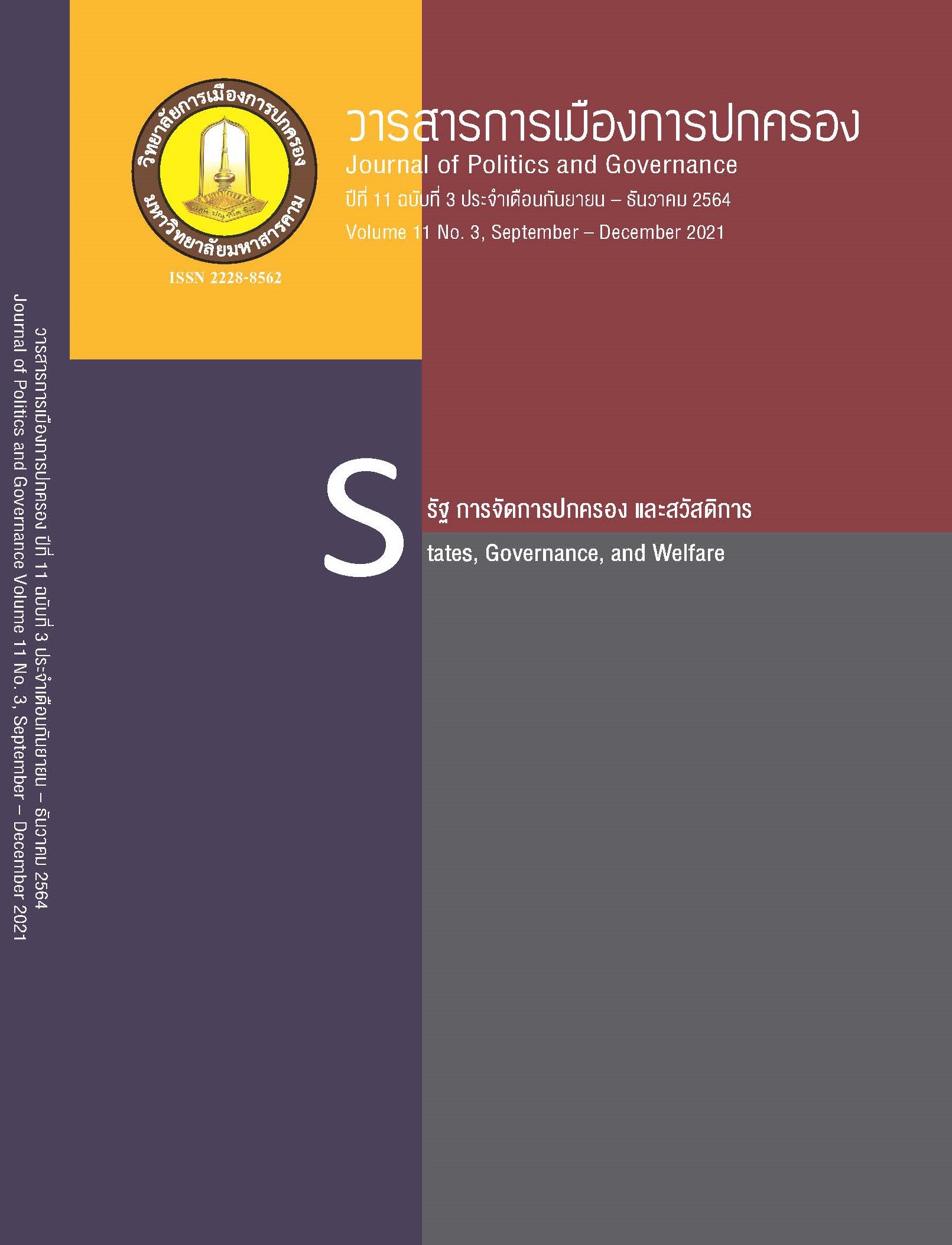Waste Management in Urban Isan Communities: Power and People Participation
Main Article Content
Abstract
The objectives of this research were: 1) to study waste management in the urban communities of Northeastern Thailand, focusing on the dimensions of power and participation, and 2) to compare waste management of urban communities with that of suburban communities, particularly in regard to the dimensions of power and participation. The data for this qualitative study was collected through in-depth interviews and focus group discussions with thirty-five key informants, comprised of employees in local administrative organizations, community leaders, community committee members, and people who participate in community waste management activities. There are two main findings of this research as follows: 1) waste management in urban Isaan communities follow a decentralization policy as set by the local administrative organizations (LAOs), in which community leaders were assigned responsibility, participation was promoted, community coordination was enhanced through household waste separation and collection, and youth awareness was strengthened; and 2) comparing an urban community (Non Nong Wat 1 in Khon Kaen) to a suburban community (Hua Thanon in Phra Lab) demonstrated that the community leaders and committees participated in waste management, eventually forming a network of communities. While the urban area was very ecologically diverse, it was also more densely populated than the suburban area and had less interaction between community members.
Article Details
References
กรมส่งเสริมการปกครองท้องถิ่น กระทรวงมหาดไทย. (2560). คู่มือปฏิบัติงานด้านการจัดการขยะมูลฝอยในเขตพื้นที่องค์กรปกครองส่วนท้องถิ่น. กรุงเทพฯ: กรมส่งเสริมการปกครองท้องถิ่น.
กรมส่งเสริมคุณภาพสิ่งแวดล้อม. (2557). 1 ทศวรรษ LA21 ก้าวสู่สังคมสีเขียว. สืบค้นจาก https://pubhtml5.com/uyipw/wixe/basic
ชาย โพธิสิตา. (2556). ศาสตร์และศิลป์การวิจัยเชิงคุณภาพ.กรุงเทพฯ: สำนักพิมพ์จุฬาฯ
ไชยณรงค์ เศรษฐเชื้อ. (2543). นิเวศวิทยาของการสร้างเขื่อนขนาดใหญ่ในประเทศไทย: กรณีศึกษาโครงการเขื่อนแก่งเสือเต้น. ศิลปศาสตรมหาบัณฑิต มหาวิทยาลัยเชียงใหม่.
พรอัมรินทร์ พรหมเกิด. (2556). สังคมวิทยาการเมือง. ภาควิชาสังคมวิทยาและมานุษยวิทยา คณะมนุษย์ศาสตร์และสังคมศาสตร์ มหาวิทยาลัยขอนแก่น. ขอนแก่น: โรงพิมพ์คลังนานา
ไพบูลย์ โพธิ์สุวรรณ. (2552). มิติใหม่ชุมชนไร้ถัง.วิทยาลัยพัฒนาการปกครองท้องถิ่น. สถาบันพระปกเกล้า
ทัชชวัฒน์ เหล่าสุวรรณ. (2554). ปฏิสัมพันธ์เชิงอำนาจในการจัดการป่าชุมชน: มิติโครงสร้างและผู้กระทำการ. ศิลปศาสตรดุษฎีบัณฑิตบัณฑิตวิทยาลัย มหาวิทยาลัยขอนแก่น.
เรืองฤทธิ์ คงอยู่. (2560). ความสัมพันธ์เชิงอำนาจของผู้นำทางการเมืองท้องถิ่นกับประชาชน. รัฐศาสตรดุษฎีบัณฑิต มหาวิทยาลัยราชภัฏมหาสารคาม
สุพิชญาย์ ปัญญา. (2557). นิเวศวิทยาการเมืองว่าด้วยการสร้างเขื่อนดอนสะโฮงแขวงจำปาสัก สาธารณรัฐประชาธิปไตยประชาชนลาว. วารสารสังคมลุ่มน้ำโขง, 10(2). พฤษภาคม-สิงหาคม.
สุภศักดิ์ เมืองพรหม. (2551). การพัฒนารูปแบบการฝึกอบรมการจัดการมูลฝอยในชุมชนบท จังหวัดร้อยเอ็ด. (วิทยานิพนธ์ปรัชญาดุษฎิบัณฑิต). มหาสารคาม: มหาวิทยาลัยมหาสารคาม.


